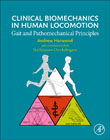
Clinical Biomechanics in Human Locomotion: Gait and Pathomechanical Principles
Horwood, Andrew
Chockalingam, Nachiappan
The interaction of genetics, epigenetics, developmental biology, and physiology under the influence of locomotive biomechanics and metabolic energetics, drives evolution. Such biological pressures on survival are essential in understanding the locomotive biomechanics of modern humans. As lifestyle, including gait speed adaptability established during the years of growth influences anatomical development, the expected biomechanics sustained during walking or running is also considered. Clinical Biomechanics in Human Locomotion: Gait and Pathomechanical Principles explores the clinical management of gait-disturbing or gait-induced pathologies and the biomechanical variance during gait between individuals. It also discusses what is required to make terrestrial human locomotion safe and what causes pathology within a context of high locomotive and morphological variability. Links human locomotive biomechanics to medicine, physiology and evolutionary anatomy and medicine Prepares students, bioengineers and clinicians for the reality of utilizing biomechanical principles in clinical practice, while informing researchers of the environment limits that most clinical biomechanics practice occur Includes further concepts in gait mechanics such as lower limb length and gait speed, and how to calculate locomotive costs INDICE: 1. Understanding Human Gait 2. Locomotive Functional Units 3. The Foot as a Functional Unit 4. Pathology Through the Principles of Biomechanics
- ISBN: 978-0-443-15860-5
- Editorial: Academic Press
- Encuadernacion: Rústica
- Fecha Publicación: 01/12/2022
- Nº Volúmenes: 1
- Idioma: Inglés
